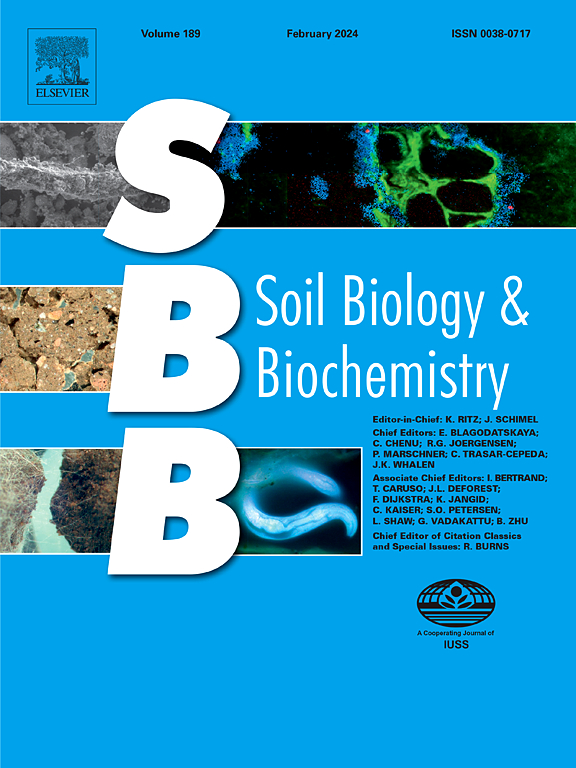减少根土接触对微生物根际建立和植物早期生长性能的影响
IF 9.8
1区 农林科学
Q1 SOIL SCIENCE
引用次数: 0
摘要
根系-土壤界面的过程对植物养分和水分的吸收至关重要,但根系-土壤接触的水平因根系性状和土壤性质而异。根土接触减少对根际、根际微生物群和植物生长性能的影响在很大程度上仍不清楚。本文在玉米微观世界试验中分析了根土接触减少的后果。通过引入人工大孔来改善土壤孔隙度,或者通过玉米突变体rth3破坏根毛发育来减少接触面积。在不接触土壤的情况下生长的根的显微评价显示,原核生物的表面定植大大减少。剩余接触区根际土壤细菌丰度也降低(2.2×1010 vs. 1.0×109每克干土16S rRNA基因拷贝数),包括氮循环细菌的丰度。根毛的缺失同样减少了细菌的丰度,尽管氮循环原核生物没有减少。基于16S rRNA基因的扩增子测序显示,根际细菌群落组成发生了变化(PERMANOVA R2=0.701, p=0.001),气孔中生长的根中Massilia和Paenibacillus的相对丰度较低。rth3植株根际的群落迁移也表现出类似的变化。内圈细菌群落的根土接触减少无明显差异。综合处理表明,根毛改善了气孔中根与土壤的接触,而侧根则减少了这种接触,这一点得到了玉米突变体lrt1侧根发育受损的验证。根-土接触减少对前3周植物生长和生物量分配的影响较弱。总体而言,根土接触水平对根际和根面细菌的生存至关重要,包括硝化细菌和潜在的植物有益类群(如Massilia)的建立。因此,通过土壤管理和植物育种策略来实现根与土壤的最佳接触有可能有助于建立一个功能根际微生物群。本文章由计算机程序翻译,如有差异,请以英文原文为准。
Implications of reduced root-soil contact for microbial rhizosphere establishment and early plant growth performance
Processes at the root-soil interface are essential for plant nutrient and water uptake, but the level of root-soil contact varies depending on root traits and soil properties. Implications of reduced root-soil contact for the rhizosphere, its microbiota and for plant performance remain largely unclear. Here, the consequences of root-soil contact reduction were analyzed in maize microcosm experiments. Either soil porosity was modified by introducing artificial large-sized pores, or the contact area was reduced by a maize mutant (rth3) impaired in root hair development. Microscopic evaluation of roots grown in pores without soil contact revealed strongly reduced prokaryotic surface colonization. Bacterial abundance in the rhizosphere soil of remaining contact areas was also reduced (2.2 × 1010 vs. 1.0 × 109 16S rRNA gene copies per g dry soil), including the abundance of nitrogen cycling bacteria. The absence of root hairs decreased bacterial abundance likewise, though not of nitrogen cycling prokaryotes. 16S rRNA gene-based amplicon sequencing revealed bacterial community-compositional alterations in the rhizosphere (PERMANOVA R2 = 0.701, p = 0.001) with lower relative abundances of Massilia and Paenibacillus for roots grown in pores. Community shifts in the rhizosphere of rth3 plants showed similar changes. No differences were evident upon root-soil contact reduction in the endosphere bacterial community. Combined manipulations revealed that root hairs improved root-soil contact in pores, whereas lateral roots reduced it, as validated with a maize mutant (lrt1) impaired in lateral root development. Plant growth and biomass allocation in the first three weeks were only weakly affected by root-soil contact reduction. Overall, the level of root-soil contact appears critical for bacterial life in the rhizosphere and rhizoplane, including the establishment of nitrifying bacteria and potential plant-beneficial taxa such as Massilia. Aiming at optimum root-soil contact by soil management and plant breeding strategies has thus the potential to contribute to the establishment of a functional rhizosphere microbiome.
求助全文
通过发布文献求助,成功后即可免费获取论文全文。
去求助
来源期刊

Soil Biology & Biochemistry
农林科学-土壤科学
CiteScore
16.90
自引率
9.30%
发文量
312
审稿时长
49 days
期刊介绍:
Soil Biology & Biochemistry publishes original research articles of international significance focusing on biological processes in soil and their applications to soil and environmental quality. Major topics include the ecology and biochemical processes of soil organisms, their effects on the environment, and interactions with plants. The journal also welcomes state-of-the-art reviews and discussions on contemporary research in soil biology and biochemistry.
 求助内容:
求助内容: 应助结果提醒方式:
应助结果提醒方式:


